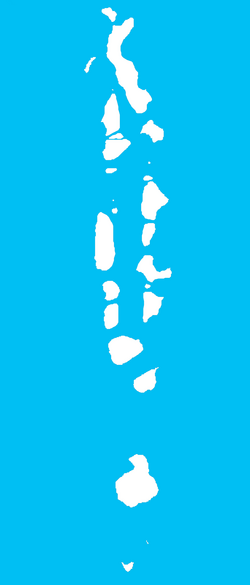Fuvahmulah
|
Fuvahmulah city ފުވައްމުލައް ސިޓީ |
|
|---|---|
| Inhabited island | |
 |
|
| Location in Maldives | |
| Coordinates: 0°16′45″S 73°24′30″E / 0.27917°S 73.40833°ECoordinates: 0°16′45″S 73°24′30″E / 0.27917°S 73.40833°E | |
| Country | Maldives |
| Geographic atoll | Gnaviyani Atoll |
| Administrative atoll | Gnaviyani Atoll |
| Distance to Malé | 494 km (307 mi) |
| Government | |
| • Council | Fuvahmulah Atoll Council |
| Area | |
| • Total | 5.13 km2 (1.98 sq mi) |
| Dimensions | |
| • Length | 6.8 km (4.2 mi) |
| • Width | 2.1 km (1.3 mi) |
| Population (october 2015) | |
| • Total | 14,380 |
| • Density | 2,800/km2 (7,300/sq mi) |
| Time zone | MST (UTC+05:00) |
Fuvahmulah (Dhivehi: ފުވައްމުލައް) is an island (atoll) in the Maldives. It is under Maldive administrative divisions of Gnaviyani Atoll or Nyaviyani Atoll. The inhabitants speak a distinctive form of the Dhivehi language, known as Mulaku bas.
Fuvahmulah means "Island of the Areca nut palms", Fuvah (or "Fua") in the local language. Other places in the world like Penang in Malaysia and Guwahati in Assam, India, are also named after this nut. The original name of the island could have been Mulah, but was called Fuvahmulah (the Mulah with the areca nut palms) to distinguish it from Boli Mulah – another island in ancient Maldives.
The admiralty charts and some geographers named the island Fua Mulaku. In old French maps the island appeared under the name Poue Molluque.
The Fuvahmulah city is about 4.5 km by 1.2 km with a submerged reef (Rashikedefaro) extending for about three km in a SE direction. In the past Fuvahmulah was a small coral atoll whose southern end was open at a spot called Diyarehifaando and the inside of the island was a saltwater lagoon forming a natural harbor. There is a spot on the southern end known as Kudhuheraival (forest of a small islet), which indicates there was a small separate islet over there in ancient times.
The channel connecting the lagoon with the ocean was closed by massive coral boulders in the past. Thus the inside of the island is lower than its edges. In time the inner lagoon lost its saltiness and all that remains today are two small lakes, wetlands and marshy taro fields. In this respect, Fuvahmulah is like the island of Nukutavake in the Central Pacific.
The northern lake of the island is known as "Dhadimagi Kilhi" (lit. "Lake of Dhadimagu" or "Dhadimagu Lake" since the lake is located in Dhadimagu ward of the island) and the southern is "Bandaara Kilhi" (lit. "State Lake" since the lake has been under state custody throughout history).
...
Wikipedia

